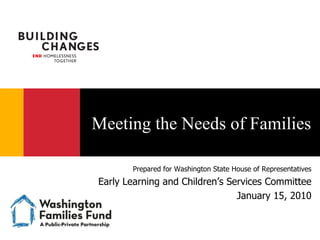
Washington Families Fund Presentation to Early Learning And Childrens Services Committee 1-15-10
- 1. Meeting the Needs of Families Prepared for Washington State House of Representatives Early Learning and Children’s Services Committee January 15, 2010
- 3. Building Changes Core Strategies
- 4. Building Changes Grantmaking Washington Families Fund – Authorized by Washington State Legislature in 2004 A public-private partnership that expands the availability of supportive housing for families in need by providing stable, long-term funding to agencies with the best models for ending family homelessness and strengthening communities throughout Washington State.
- 5. Washington Families Fund A Public-Private Partnership • Funding partners: 23 • Fund total: $26 million • Awards-to-date: $15.8 million • Counties: 15 • Nonprofit programs statewide: 43 • Service-enriched housing units: 618 • Families supported: 1,009
- 6. WFF Funded Programs by DSHS Region $4,072,130 163 units $1,032,195 47 units $4,448,877 152 units $2,109,290 126 units $2,864,185 $1,225,000 95 units 35 units
- 7. Washington Families Fund Primary Goals for Families • Greater housing stability, including a transition to permanent housing upon program completion • Improved economic and educational advancement • Increased access to and use of needed community based services and support • Greater likelihood of family stability including re- unification and increased stability in childcare and school attendance
- 8. Washington Families Fund Family Outcomes to Date Who Are The Families Served and Are We Meeting Their Needs?
- 9. Moderate-Needs Families – Profile Typical parent is: • Female (92%) • Average Age 31 years • Average of 2 children • HS Diploma or greater (66%) • First time Homeless (60.74%) • Experienced DV (66%) • Disabling Condition (34%) • TANF Recipient (66%) • Working (24%)
- 10. Moderate-Needs Families – Overview (Five Year Data) • Total families served: 940 • Adults: 1,103 • Children:1,755 • Families exited housing: 491 • Average length of stay: 11.4 months
- 11. Moderate-Needs Families – Housing (Five Year Data) Majority of Families Secure a Permanent Home After Completing a WFF Program 73% 80% 60% 40% 20% 9% 6% 6% 6% 0% Permanent Living with Transitional Homeless Other Housing Family/Friends Housing Situation
- 12. Moderate-Needs Families – Sources of Income (Five Year Data) Increase in Economic Stability Intake Exit % Change TANF 68% 55% -13 Employment 24% 36% 12 SSI/SSDI 9% 12% 3
- 13. Moderate-Needs Families – Monthly Income (Five Year Data) Majority of Families Increase Monthly Income; Yet Remain Far Below Self-Sufficiency Standard $3,300 $3,500 $3,000 $2,500 $2,000 $1,249 $1,500 $987 $1,000 $500 $- Intake Exit Self Sufficiency
- 14. Moderate-Needs Families – School Stability (Five Year Data) School Stability Improves with Housing Stability • School age children attended 2 schools, on average, in the last year • With housing stability: 80% increase in the number of children remaining in the same school
- 15. Moderate-Needs Families – Programs Helping Hand House: Rural Bright Futures Case management and support services in rural Pierce County. Consejo Counseling and Referral Service: Villa Esperanza Case management, health services and legal advocacy services for Latino families who are homeless due to domestic violence in South King County. Transitions: Spokane Family Futures An innovative collaboration between four organizations to provide support services in conjunction with Section 8 vouchers.
- 16. Washington Families Fund Making Progress Housing Stability Increased Income School Stability
- 17. Washington Families Fund Meeting Challenges • Affordable market rate housing • About a quarter of families exit program without stable housing
- 18. Washington Families Fund Creating Solutions High-Needs Family Service Model • Developed a screening tool to better identify needs and target families with multiple barriers • Fund programs targeting families with greater needs mental health substance abuse domestic violence and trauma children living away from home
- 19. High-Needs Families – Programs Volunteers of America: Housing First – Sky Valley Case management, dedicated drug, alcohol, and mental health treatment, access to basic medical and dental care, and life skills training in Snohomish County. Abused Deaf Women’s Advocacy Services: A Place of Our Own Intensive case management and wrap-around supportive services in Seattle to chronically homeless Deaf and Deaf-Blind adults and their children who are also victims of domestic violence.
- 20. High-Needs Families – Initial Findings (Baseline Data) • Initial baseline assessment data on 57 High-Needs Families; composed of 66 adults, 88 children and an additional 35 children living away from the household • Initial findings reveal that 85% of parents have substantial housing barriers and service needs
- 21. High-Needs Families – Profile Typical parent is: • Female (86%) • Average Age 33 years • Average of 2.4 children • Has a child living away (42.1%) • HS Diploma or greater (52%) • Homeless > 3 times (51%) • Experienced Violence (93%) • Disabling Condition (68%) • TANF Recipient (63%) • Working (12%)
- 22. High-Needs Families – Barriers to Housing (Baseline Data) Emerging Profile of Chronically Homeless Families Average number of times homeless in lifetime 9.9 At least one child living apart 42% Open Child Protective Services (CPS) plan 25% Experience of physical or sexual violence 93% Chronic or ongoing medical problem 68%
- 23. Washington Families Fund Looking Ahead • The Right Services to Families at the Right Time • Breaking the Cycle of Homelessness • Three-county Pilot Program
- 24. Washington Families Fund Making Progress • Most families are stably housed with rising employment and incomes; children are stable in schools • Identifying and working on solutions to address chronic family homelessness • Supporting systems change through pilots in three counties
